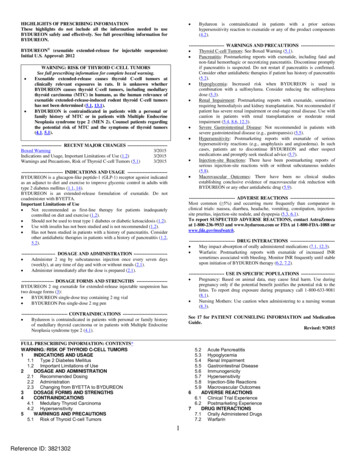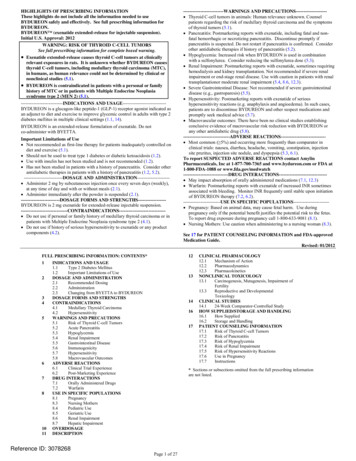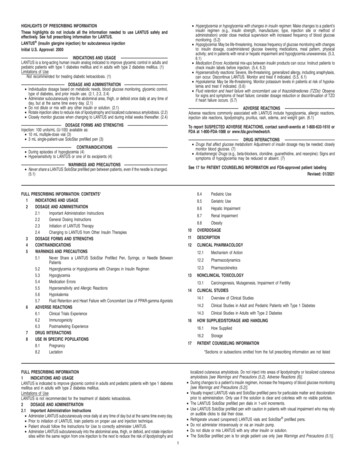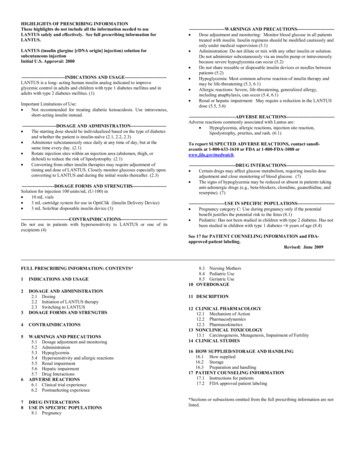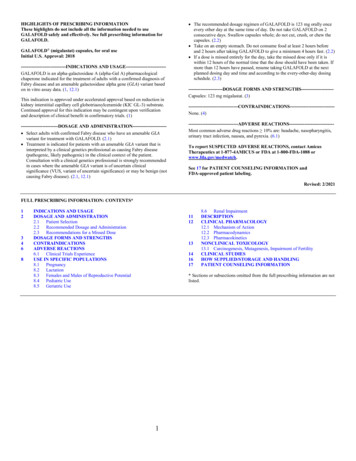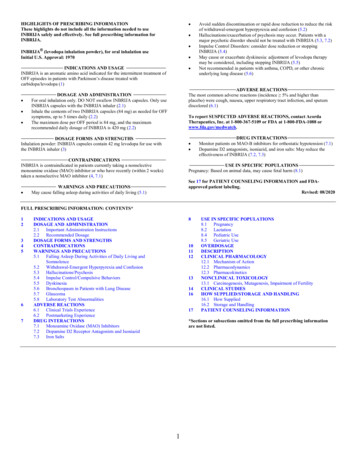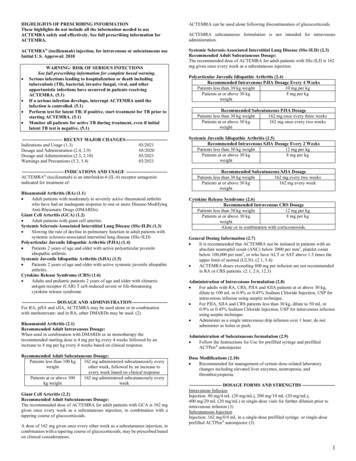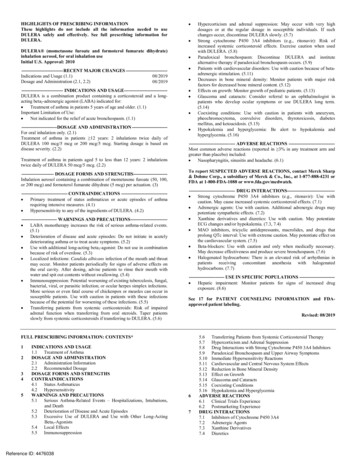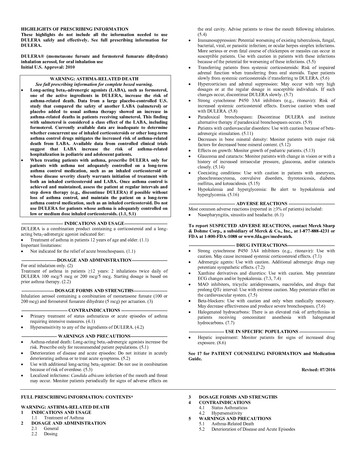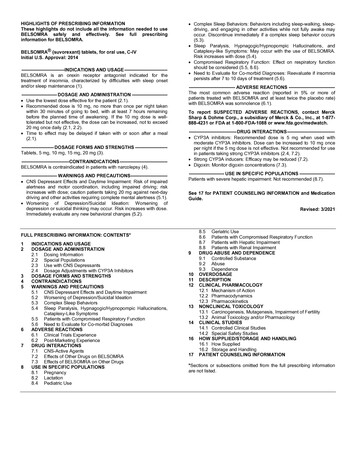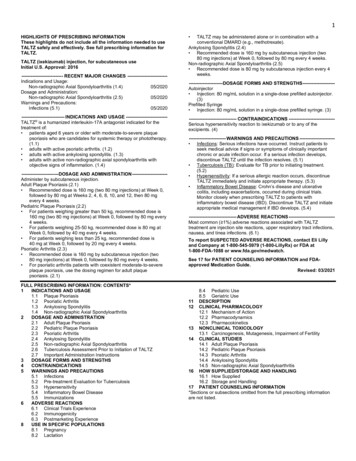
Transcription
1HIGHLIGHTS OF PRESCRIBING INFORMATIONThese highlights do not include all the information needed to useTALTZ safely and effectively. See full prescribing information forTALTZ.TALTZ (ixekizumab) injection, for subcutaneous useInitial U.S. Approval: 2016--------------------------- RECENT MAJOR CHANGES -------------------------Indications and Usage:Non-radiographic Axial Spondyloarthritis (1.4)05/2020Dosage and Administration:Non-radiographic Axial Spondyloarthritis (2.5)05/2020Warnings and Precautions:Infections (5.1)05/2020---------------------------- INDICATIONS AND USAGE --------------------------TALTZ is a humanized interleukin-17A antagonist indicated for thetreatment of: patients aged 6 years or older with moderate-to-severe plaquepsoriasis who are candidates for systemic therapy or phototherapy.(1.1) adults with active psoriatic arthritis. (1.2) adults with active ankylosing spondylitis. (1.3) adults with active non-radiographic axial spondyloarthritis withobjective signs of inflammation. (1.4)------------------------DOSAGE AND ADMINISTRATION ----------------------Administer by subcutaneous injection.Adult Plaque Psoriasis (2.1) Recommended dose is 160 mg (two 80 mg injections) at Week 0,followed by 80 mg at Weeks 2, 4, 6, 8, 10, and 12, then 80 mgevery 4 weeks.Pediatric Plaque Psoriasis (2.2) For patients weighing greater than 50 kg, recommended dose is160 mg (two 80 mg injections) at Week 0, followed by 80 mg every4 weeks. For patients weighing 25-50 kg, recommended dose is 80 mg atWeek 0, followed by 40 mg every 4 weeks. For patients weighing less than 25 kg, recommended dose is40 mg at Week 0, followed by 20 mg every 4 weeks.Psoriatic Arthritis (2.3) Recommended dose is 160 mg by subcutaneous injection (two80 mg injections) at Week 0, followed by 80 mg every 4 weeks. For psoriatic arthritis patients with coexistent moderate-to-severeplaque psoriasis, use the dosing regimen for adult plaquepsoriasis. (2.1)FULL PRESCRIBING INFORMATION: CONTENTS*1INDICATIONS AND USAGE1.1 Plaque Psoriasis1.2 Psoriatic Arthritis1.3 Ankylosing Spondylitis1.4 Non-radiographic Axial Spondyloarthritis2DOSAGE AND ADMINISTRATION2.1 Adult Plaque Psoriasis2.2 Pediatric Plaque Psoriasis2.3 Psoriatic Arthritis2.4 Ankylosing Spondylitis2.5 Non-radiographic Axial Spondyloarthritis2.6 Tuberculosis Assessment Prior to Initiation of TALTZ2.7 Important Administration Instructions3DOSAGE FORMS AND STRENGTHS4CONTRAINDICATIONS5WARNINGS AND PRECAUTIONS5.1 Infections5.2 Pre-treatment Evaluation for Tuberculosis5.3 Hypersensitivity5.4 Inflammatory Bowel Disease5.5 Immunizations6ADVERSE REACTIONS6.1 Clinical Trials Experience6.2 Immunogenicity6.3 Postmarketing Experience8USE IN SPECIFIC POPULATIONS8.1 Pregnancy8.2 Lactation TALTZ may be administered alone or in combination with aconventional DMARD (e.g., methotrexate).Ankylosing Spondylitis (2.4) Recommended dose is 160 mg by subcutaneous injection (two80 mg injections) at Week 0, followed by 80 mg every 4 weeks.Non-radiographic Axial Spondyloarthritis (2.5) Recommended dose is 80 mg by subcutaneous injection every 4weeks.----------------------DOSAGE FORMS AND STRENGTHS--------------------Autoinjector Injection: 80 mg/mL solution in a single-dose prefilled autoinjector.(3)Prefilled Syringe Injection: 80 mg/mL solution in a single-dose prefilled syringe. (3)------------------------------- CONTRAINDICATIONS -----------------------------Serious hypersensitivity reaction to ixekizumab or to any of theexcipients. (4)------------------------ WARNINGS AND PRECAUTIONS ---------------------- Infections: Serious infections have occurred. Instruct patients toseek medical advice if signs or symptoms of clinically importantchronic or acute infection occur. If a serious infection develops,discontinue TALTZ until the infection resolves. (5.1) Tuberculosis (TB): Evaluate for TB prior to initiating treatment.(5.2) Hypersensitivity: If a serious allergic reaction occurs, discontinueTALTZ immediately and initiate appropriate therapy. (5.3) Inflammatory Bowel Disease: Crohn’s disease and ulcerativecolitis, including exacerbations, occurred during clinical trials.Monitor closely when prescribing TALTZ to patients withinflammatory bowel disease (IBD). Discontinue TALTZ and initiateappropriate medical management if IBD develops. (5.4)------------------------------- ADVERSE REACTIONS -----------------------------Most common ( 1%) adverse reactions associated with TALTZtreatment are injection site reactions, upper respiratory tract infections,nausea, and tinea infections. (6.1)To report SUSPECTED ADVERSE REACTIONS, contact Eli Lillyand Company at 1-800-545-5979 (1-800-LillyRx) or FDA at1-800-FDA-1088 or www.fda.gov/medwatch.See 17 for PATIENT COUNSELING INFORMATION and FDAapproved Medication Guide.Revised: 03/20218.4 Pediatric Use8.5 Geriatric Use11 DESCRIPTION12 CLINICAL PHARMACOLOGY12.1 Mechanism of Action12.2 Pharmacodynamics12.3 Pharmacokinetics13 NONCLINICAL TOXICOLOGY13.1 Carcinogenesis, Mutagenesis, Impairment of Fertility14 CLINICAL STUDIES14.1 Adult Plaque Psoriasis14.2 Pediatric Plaque Psoriasis14.3 Psoriatic Arthritis14.4 Ankylosing Spondylitis14.5 Non-radiographic Axial Spondyloarthritis16 HOW SUPPLIED/STORAGE AND HANDLING16.1 How Supplied16.2 Storage and Handling17 PATIENT COUNSELING INFORMATION*Sections or subsections omitted from the full prescribing informationare not listed.
2FULL PRESCRIBING INFORMATION11.1INDICATIONS AND USAGEPlaque PsoriasisTALTZ is indicated for the treatment of patients 6 years of age and older with moderate-to-severe plaquepsoriasis who are candidates for systemic therapy or phototherapy.1.2Psoriatic ArthritisTALTZ is indicated for the treatment of adult patients with active psoriatic arthritis.1.3Ankylosing SpondylitisTALTZ is indicated for the treatment of adult patients with active ankylosing spondylitis.1.4Non-radiographic Axial SpondyloarthritisTALTZ is indicated for the treatment of adult patients with active non-radiographic axial spondyloarthritis (nraxSpA) with objective signs of inflammation.22.1DOSAGE AND ADMINISTRATIONAdult Plaque PsoriasisTALTZ is administered by subcutaneous injection. The recommended dose is 160 mg (two 80 mg injections) atWeek 0, followed by 80 mg at Weeks 2, 4, 6, 8, 10, and 12, then 80 mg every 4 weeks.2.2Pediatric Plaque PsoriasisTALTZ is administered by subcutaneous injection every 4 weeks (Q4W). The recommended dose in pediatricpatients from 6 to less than 18 years of age with moderate-to-severe plaque psoriasis is based on the following weightcategories.Table 1: Recommended Dosing and Administration for Pediatric PatientsPediatric Patient’s WeightStarting Dose (Week 0)Dose every 4 weeks (Q4W) ThereafterGreater than 50 kg160 mg (two 80 mg injections)80 mg25 to 50 kg80 mg40 mgLess than 25 kg40 mg20 mg2.3Psoriatic ArthritisThe recommended dose is 160 mg by subcutaneous injection (two 80 mg injections) at Week 0, followed by 80 mgevery 4 weeks.For psoriatic arthritis patients with coexistent moderate-to-severe plaque psoriasis, use the dosing regimen foradult plaque psoriasis [see Dosage and Administration (2.1)].TALTZ may be administered alone or in combination with a conventional disease-modifying antirheumatic drug(cDMARD) (e.g., methotrexate).2.4Ankylosing SpondylitisThe recommended dose is 160 mg by subcutaneous injection (two 80 mg injections) at Week 0, followed by 80 mgevery 4 weeks.2.5Non-radiographic Axial SpondyloarthritisThe recommended dose is 80 mg by subcutaneous injection every 4 weeks.2.6Tuberculosis Assessment Prior to Initiation of TALTZEvaluate patients for tuberculosis (TB) infection prior to initiating treatment with TALTZ [see Warnings andPrecautions (5.2)].2.7Important Administration InstructionsTALTZ is intended for use under the guidance and supervision of a physician. Adult patients may self-inject orcaregivers may give injections of TALTZ 80 mg after training in subcutaneous injection technique using the autoinjector orprefilled syringe. Caregivers may give injections of TALTZ 80 mg to pediatric patients weighing more than 50 kg using theautoinjector or prefilled syringe after training and demonstration of proper subcutaneous injection technique.The TALTZ “Instructions for Use” contains more detailed instructions on the preparation and administration ofTALTZ [see Instructions for Use].Before injection, remove TALTZ autoinjector or TALTZ prefilled syringe from the refrigerator and allow TALTZ toreach room temperature (30 minutes) without removing the needle cap. Inspect TALTZ visually for particulate matter anddiscoloration prior to administration. TALTZ is a clear and colorless to slightly yellow solution. Do not use if the liquidcontains visible particles, is discolored or cloudy (other than clear and colorless to slightly yellow).Administer each injection at a different anatomic location (such as upper arms, thighs or any quadrant ofabdomen) than the previous injection, and not into areas where the skin is tender, bruised, erythematous, indurated or
3affected by psoriasis. Administration of TALTZ in the upper, outer arm may be performed by a caregiver or healthcareprovider [see Instructions for Use].TALTZ does not contain preservatives, therefore discard any unused product.If a dose is missed, administer the dose as soon as possible. Thereafter, resume dosing at the regular scheduledtime.Pediatric Patients Weighing 50 kg or LessTALTZ doses of 20 mg or 40 mg [see Dosage and Administration (2.2)] must be prepared and administered by aqualified healthcare professional. Use only the commercial TALTZ 80 mg/1 mL prefilled syringe when preparing theprescribed 20 mg and 40 mg pediatric dose.1. Gather the following necessary supplies for preparation: 0.5 mL or 1 mL disposable syringe Sterile needle for withdrawal 27-gauge sterile needle for administration Sterile, clear glass vial.2. Expel the entire contents of the prefilled syringe into the sterile vial. DO NOT shake or swirl the vial. No othermedications should be added to solutions containing TALTZ.3. Using the 0.5 mL or 1 mL disposable syringe and sterile needle, withdraw the prescribed dose from the vial(0.25 mL for 20 mg; 0.5 mL for 40 mg).4. Remove the needle from the syringe and replace it with a 27-gauge needle prior to administering TALTZ to thepatient.StorageIf necessary, the prepared TALTZ may be stored at room temperature for up to 4 hours from first puncturing thesterile vial.3DOSAGE FORMS AND STRENGTHSTALTZ is a clear and colorless to slightly yellow solution available as:Autoinjector Injection: 80 mg/mL solution of TALTZ in a single-dose prefilled autoinjectorPrefilled Syringe Injection: 80 mg/mL solution of TALTZ in a single-dose prefilled syringe4CONTRAINDICATIONSTALTZ is contraindicated in patients with a previous serious hypersensitivity reaction, such as anaphylaxis, toixekizumab or to any of the excipients [see Warnings and Precautions (5.3)].55.1WARNINGS AND PRECAUTIONSInfectionsTALTZ may increase the risk of infection. In clinical trials in adult patients with plaque psoriasis, the TALTZ grouphad a higher rate of infections than the placebo group (27% vs. 23%). Upper respiratory tract infections, oral candidiasis,conjunctivitis and tinea infections occurred more frequently in the TALTZ group than in the placebo group. A similarincrease in risk of infection was seen in placebo-controlled trials in patients with pediatric psoriasis, psoriatic arthritis,ankylosing spondylitis, and non-radiographic axial spondyloarthritis [see Adverse Reactions (6.1)].Instruct patients treated with TALTZ to seek medical advice if signs or symptoms of clinically important chronic oracute infection occur. If a patient develops a serious infection or is not responding to standard therapy, monitor the patientclosely and discontinue TALTZ until the infection resolves.5.2Pre-treatment Evaluation for TuberculosisEvaluate patients for tuberculosis (TB) infection prior to initiating treatment with TALTZ. Do not administer topatients with active TB infection. Initiate treatment of latent TB prior to administering TALTZ. Consider anti-TB therapyprior to initiating TALTZ in patients with a past history of latent or active TB in whom an adequate course of treatmentcannot be confirmed. Patients receiving TALTZ should be monitored closely for signs and symptoms of active TB duringand after treatment.5.3HypersensitivitySerious hypersensitivity reactions, including angioedema and urticaria (each 0.1%), occurred in the TALTZ groupin clinical trials. Anaphylaxis, including cases leading to hospitalization, has been reported in post marketing use withTALTZ [see Adverse Reactions (6.1, 6.3)]. If a serious hypersensitivity reaction occurs, discontinue TALTZ immediatelyand initiate appropriate therapy.
45.4Inflammatory Bowel DiseasePatients treated with TALTZ may be at increased risk of inflammatory bowel disease. In clinical trials, Crohn’sdisease and ulcerative colitis, including exacerbations, occurred at a greater frequency in the TALTZ group than theplacebo control group [see Adverse Reactions (6.1)]. During TALTZ treatment, monitor for onset or exacerbation ofinflammatory bowel disease and if IBD occurs, discontinue TALTZ and initiate appropriate medical management.5.5ImmunizationsPrior to initiating therapy with TALTZ, consider completion of all age appropriate immunizations according tocurrent immunization guidelines. Avoid use of live vaccines in patients treated with TALTZ. No data are available on theresponse to live vaccines.6ADVERSE REACTIONSThe following adverse drug reactions are discussed in greater detail in other sections of the label: Infections [see Warnings and Precautions (5.1)] Hypersensitivity Reactions [see Contraindications (4) and Warnings and Precautions (5.3)] Inflammatory Bowel Disease [see Warnings and Precautions (5.4)]6.1Clinical Trials ExperienceBecause clinical trials are conducted under widely varying and controlled conditions, adverse reaction ratesobserved in the clinical trials of a drug cannot be directly compared to rates in the clinical trials of another drug and maynot reflect the rates observed in practice.Adult Plaque PsoriasisWeeks 0 to 12:Three placebo-controlled trials in subjects with plaque psoriasis were integrated to evaluate the safety of TALTZcompared to placebo for up to 12 weeks. A total of 1167 subjects (mean age 45 years; 66% men; 94% White) with plaquepsoriasis received TALTZ (160 mg at Week 0, 80 mg every 2 weeks [Q2W] for 12 weeks) subcutaneously. In two of thetrials, the safety of TALTZ (use up to 12 weeks) was also compared with an active comparator, U.S. approved etanercept[see Clinical Studies (14)].In the 12-week, placebo-controlled period, adverse events occurred in 58% of the TALTZ Q2W group (2.5 persubject-year of follow-up) compared with 47% of the placebo group (2.1 per subject-year of follow-up). Serious adverseevents occurred in 2% of the TALTZ group (0.07 per subject-year of follow-up), and in 2% of the placebo group (0.07 persubject-year of follow-up).Table 2 summarizes the adverse reactions that occurred at a rate of at least 1% and at a higher rate in the TALTZgroup than in the placebo group during the 12-week placebo-controlled period of the pooled clinical trials.abTable 2: Adverse Reactions Occurring in 1% of the TALTZ Group and More Frequently than in the PlaceboGroup in the Plaque Psoriasis Clinical Trials through Week 12Adverse ReactionsTALTZ 80 mg Q2WEtanerceptbPlacebo(N 1167) n (%)(N 287) n (%)(N 791) n (%)Injection site reactions196 (17)32 (11)26 (3)Upper respiratory tract infectionsa163 (14)23 (8)101 (13)Nausea23 (2)1 ( 1)5 (1)Tinea infections17 (2)01 ( 1)Upper respiratory tract infections cluster includes nasopharyngitis and rhinovirus infection.U.S. approved etanercept.Adverse reactions that occurred at rates less than 1% in the TALTZ group and more frequently than in the placebogroup during the 12-week induction period included rhinitis, oral candidiasis, urticaria, influenza, conjunctivitis,inflammatory bowel disease, and angioedema.Weeks 13 to 60:A total of 332 subjects received the recommended maintenance regimen of TALTZ 80 mg dosed every 4 weeks.During the maintenance period (Weeks 13 to 60), adverse events occurred in 80% of subjects treated with TALTZ(1.0 per subject-year of follow-up) compared to 58% of subjects treated with placebo (1.1 per subject-year of follow-up).Serious adverse events were reported in 4% of subjects treated with TALTZ (0.05 per subject-year of follow-up) and nonein the subjects treated with placebo.Weeks 0 to 60:Over the entire treatment period (Weeks 0 to 60), adverse events were reported in 67% of subjects treated withTALTZ (1.4 per subject-year of follow-up) compared to 48% of subjects treated with placebo (2.0 per subject-year offollow-up). Serious adverse events were reported in 3% of subjects treated with TALTZ (0.06 per subject-year of followup), and in 2% of subjects treated with placebo (0.06 per subject-year of follow-up).
5Specific Adverse Drug Reactions:Injection Site ReactionsThe most frequent injection site reactions were erythema and pain. Most injection site reactions were mild-tomoderate in severity and did not lead to discontinuation of TALTZ.InfectionsIn the 12-week, placebo-controlled period of the clinical trials in plaque psoriasis, infections occurred in 27% ofsubjects treated with TALTZ (1.2 per subject-year of follow-up) compared to 23% of subjects treated with placebo (1.0 persubject-year of follow-up). Serious infections occurred in 0.4% of subjects treated with TALTZ (0.02 per subject-year offollow-up) and in 0.4% of subjects treated with placebo (0.02 per subject-year of follow-up) [see Warnings andPrecautions (5.1)].During the maintenance treatment period (Weeks 13 to 60), infections occurred in 57% of subjects treated withTALTZ (0.70 per subject-year of follow-up) compared to 32% of subjects treated with placebo (0.61 per subject-year offollow-up). Serious infections occurred in 0.9% of subjects treated with TALTZ (0.01 per subject-year of follow-up) andnone in the subjects treated with placebo.Over the entire treatment period (Weeks 0 to 60), infections were reported in 38% of subjects treated with TALTZ(0.83 per subject-year of follow-up) compared to 23% of subjects treated with placebo (1.0 per subject-year of follow-up).Serious infections occurred in 0.7% of subjects treated with TALTZ (0.02 per subject-year of follow-up), and in 0.4% ofsubject treated with placebo (0.02 per subject-year of follow-up).Inflammatory Bowel DiseaseIn adult subjects with plaque psoriasis, Crohn’s disease and ulcerative colitis, including exacerbations, occurred ata greater frequency in the TALTZ 80 mg Q2W group (Crohn’s disease 0.1%, ulcerative colitis 0.2%) than the placebogroup (0%) during the 12-week, placebo-controlled period in clinical trials [see Warnings and Precautions (5.4)].Laboratory Assessment of CytopeniaNeutropeniaOver the entire treatment period (Weeks 0 to 60), neutropenia occurred in 11% of subjects treated with TALTZ(0.24 per subject-year of follow-up) compared to 3% of subjects treated with placebo (0.14 per subject-year of follow-up).In subjects treated with TALTZ, the incidence rate of neutropenia during Weeks 13 to 60 was lower than the incidencerate during Weeks 0 to 12.In the 12-week, placebo-controlled period, neutropenia Grade 3 ( 1,000 cells/mm3) occurred in 0.2% of theTALTZ group (0.007 per subject-year of follow-up) compared to 0.1% of the placebo group (0.006 per subject-year offollow-up). The majority of cases of neutropenia were either Grade 2 (2% for TALTZ 80 mg Q2W versus 0.3% for placebo; 1,000 to 1,500 cells/mm3) or Grade 1 (7% for TALTZ 80 mg Q2W versus 3% for placebo; 1,500 cells/mm3 to 2,000 cells/mm3). Neutropenia in the TALTZ group was not associated with an increased rate of infection compared tothe placebo group.ThrombocytopeniaNinety eight percent of cases of thromboc
2 FULL PRESCRIBING INFORMATION 1 INDICATIONS AND USAGE 1.1 Plaque Psoriasis TALTZ is indicated for the treatment of patients 6 years of age and older with moderate-to-severe plaque psoriasis
